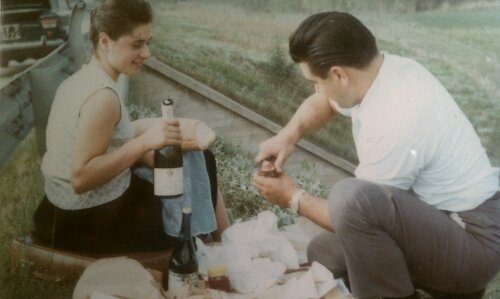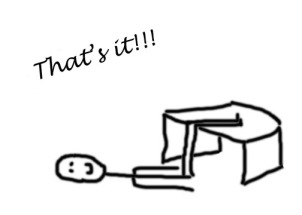“Oh boy, your legs are as tight as a marathoner’s!” My alexander technique practitioner was working on manually loosening my legs, which were dangling down with gravity as I straddled a wooden vault she referred to as “the horse.” The surprise in her voice, and the fact that I hadn’t gone for a run in over two years, made it clear that this tightness is not normal. For as long as I can remember, neither leg has ever been able to lift past 90 degrees of the other when lying down on my back. I’ve always blamed my skinny legs, and subsequently tight hamstrings and leg muscles, on my Mom. It’s been said that my Dad married her for her legs and mean pasta dishes, but while skinny legs may help win you a man, they prove a disadvantage for practical uses.
(My parents enjoying a picnic during their honeymoon road trip, Italian style.)
At 27 I am battling patella tendonitis that prevents me from running, steep hikes, or any other activity that requires strong knees. Despite yoga and strengthening exercises, the familiar aches have not gone away, and after a frustrating 2 years, I had decided to try Alexander Technique. Unlike previous physical therapists I worked with, my AT practitioner’s focus was on relaxing and loosening the legs as opposed to strengthening them. The main exercise that she stressed I do at home is called “constructive rest,” where you lie on your back with your legs raised up on a chair. That’s it….you just lie there for 20 mins. She said this exercise was important to allow my knees to relax and heal.
Relax. Interestingly enough, this was the one exercise out of the several she gave me to do at home that I had the hardest time completing consistently. And each week she would emphasize its importance again and again, as if psychically knowing that I wasn’t doing it. Why wasn’t I doing it?? I wasn’t consciously avoiding it. It didn’t hurt, nor was it at all difficult. But it required 20 mins of stillness, 20 mins of doing nothing, 20 mins void of multitasking or completing something. And carving out those 20 mins proved harder than I realized, since there was always something “more pressing” that needed to get done instead. I would always relegate it to the last thing to do before bedtime, but by the time I was ready to go to sleep, I was so exhausted that I climbed into bed instead.
More interestingly, when I did actually do the exercise, I’d feel my whole body relax (including my stomach area which so often gives me strife), and after 10 mins or so of just lying there, the usual bloating or stomach discomfort I had would dissipate. While this is designed as a physical body alignment exercise, for me it basically became a meditation (or you can formally make it into one as you have nothing else to do!). Oftentimes I would just sit there and breathe, and consciously put my focus on my stomach area, and then my knees, and just think about healing them. Each time I went through with the exercise I would be surprised how much more tranquil and rested I’d feel afterwards, from my head down to my toes.
And I would again be reminded, like so many other times during my healing journey, that the root of my physical woes was ultimately tension. I laugh at all the time and money spent on various healing modalities for my stomach and legs, when at the end of the day the main cause of all of it is my stubborn refusal to relax. “Stress” seems a cop-out cause for any issue, as it is an illusive thing that is as simplistic as it is hard to manage. And for some reason, it is preferable to have a complex explanation for our issues than simple ones. Instead of sitting with myself quietly, tuning in and breathing deeply into my body, acknowledging how I feel and providing a safe and attentive space for listening, I much prefer rushing around to appointments for virtually every healing modality under the sun, no matter the cost. Not that they haven’t all been wonderful learning experiences, but in the end the core issue is always the same one. Regardless of how many doctors I see, the tension will not go away unless acknowledged up front – and I need to be the one doing the acknowledging.
(Have the courage to face the light. Photo taken in a park tunnel in Berkeley.)
So how does one deal with tension? What does it mean? I see tension as a holding on, a grabbing, a refusal to let go. It is ultimately stagnant, stubborn energy that works itself up in knots in your body. Like any issue, acknowledgment is the first step to healing. And sometimes listening is enough. An inspirational writer and coach, Kim Childs, talks beautifully about the power of listening here. When you listen, and are simply receptive to what is without judgement or racing thoughts, you are able to fully see things as they are. No distractions. And in that state of observation, free of attachment, judgment or expectation, the need for “holding on” evaporates. This space of presence is an excellent place to recognize what specifically we are holding on to that is causing the tension in our legs and stomachs – what fears, relationships, expectations, judgments, or traumas we have been desperately clinging to (likely subconsciously), that will continue to drag us down unless dealt with and “digested” fully. While tuning-in may seem an easy process, it is actually a difficult one that requires courage. It takes courage to dive into discomfort with oneself, to be honest with how we feel and what makes us vulnerable. It takes courage to face these vulnerabilities full-on and perhaps allow tears to flow as we finally acknowledge them and release their hold on us.
Of all the healing modalities I’ve tried, those that allow you to face yourself honestly and release stagnant energy (tension), whether it be through crying, dancing, singing or screaming, are the most productive. Ultimately, it’s about recognizing tight holds of attachment to things that no longer serve us (and are causing dis-ease in our bodies as a result) and detaching from them. This is why cleaning out a closet or home can feel so good. We are constantly getting bombarded with information and experiences every moment. Just as a kitchen sink fills up with dishes, we need to digest and cleanse our systems of the thoughts, feelings and judgments that get processed along with our experiences.
At the next sign of unidentifiable physical discomfort, I urge you to take a few minutes and tune-in, and see if it’s simply a form of tension that needs to be let go.



